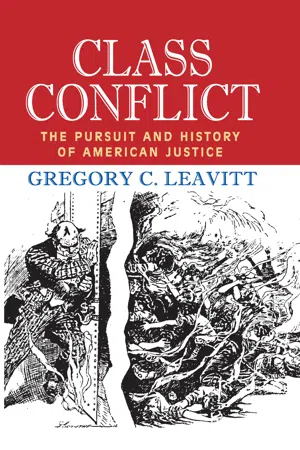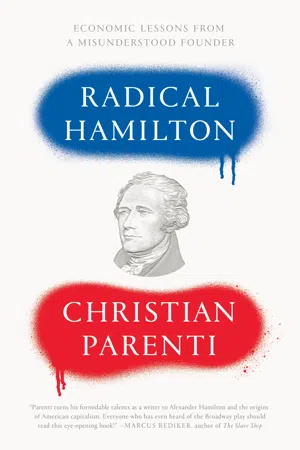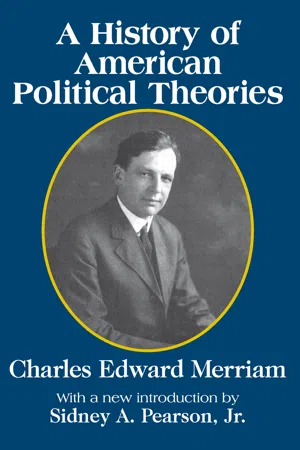Politics & International Relations
Articles of Confederation
The Articles of Confederation was the first constitution of the United States, adopted in 1777 and ratified in 1781. It established a weak central government with most power held by the individual states. The Articles ultimately proved ineffective in governing the nation, leading to the drafting of the U.S. Constitution in 1787.
Written by Perlego with AI-assistance
Related key terms
4 Key excerpts on "Articles of Confederation"
- eBook - ePub
American Government
Constitutional Democracy Under Pressure
- Cal Jillson(Author)
- 2020(Publication Date)
- Routledge(Publisher)
Articles of Confederation Written in the Continental Congress in 1776 and 1777, the Articles outlining America’s first national government were finally adopted on March 1, 1781. The Articles were replaced by the U.S. Constitution on March 4, 1789.The Articles of Confederation. The Articles of Confederation produced a “league” of states, not a nation of citizens. Each state delegation to the Confederation Congress had a single vote, and the presidency of the Congress rotated among the states. There was no executive, no judiciary, no separation of powers, and no checks and balances. The Revolution created an increased sense of unity among Americans, but not yet a sense of nationhood.Confederation Congress The Congress served under the Articles of Confederation from its adoption on March 1, 1781, until it was superseded by the new Federal Congress when the U.S. Constitution went into effect on March 4, 1789.The Confederation Congress’s authority over foreign policy included sending and receiving ambassadors, negotiating treaties and alliances, and making decisions of war and peace. Congress was empowered to regulate its own coinage, fix the standards for weights and measures, establish a postal system, regulate trade with Native Americans living outside the individual states, and appoint the senior officers of army and navy units serving under the control of the Congress. Congress was authorized to borrow money and to requisition the states for money, men, and materials needed to fight the war and support Congress’s other activities.However, certain critical powers were denied to Congress altogether. Congress had no power to regulate trade and commerce between the states or to tax the citizens of the individual states. Congress’s only domestic source of revenue was requisitions on the states. Finally, amendments to the Articles required the unanimous approval of the thirteen state legislatures. No amendment ever passed because at least one state always opposed, no matter how critical the need seemed to the others.In a nation fighting its way to independence, the flaws and weaknesses of the Articles were frustrating to many and infuriating to some—including General Washington. The root of the problem was that while Congress could requisition from the states the men and supplies needed to fight the war, it was the hard-pressed states that decided whether to comply in full, in part, or not at all. Even after independence was secured, Congress’s inability to resolve commercial disputes, or even consistently to keep a quorum, deepened pessimism about the new nation’s future. - eBook - ePub
Class Conflict
The Pursuit and History of American Justice
- Gregory C. Leavitt(Author)
- 2017(Publication Date)
- Routledge(Publisher)
Imprudently, perhaps, given the conciliatory sentiment behind the passage of the Plan of Union, the First Continental Congress also passed the Articles of Association implementing a boycott against British imports. Within a year, British imports dropped 97 percent, the boycott being largely enforced by crowds of common Americans. It seemed, however, that the time for reconciliation had already passed as ordinary Americans had already taken up arms against the British. The First Continental Congress acted to provide a second meeting in May of 1775. In addition to the American colonies, invitations to the Second Congress were extended to Quebec, Saint John’s Island, and Nova Scotia, though none sent delegates. When the Second Continental Congress met in Philadelphia in 1775, the Revolutionary War was underway and individual states were seceding from Britain. At this point, the Continental Congress became the organizational body for managing the Revolutionary War, though it had little true authority. While the need for an umbrella authority was quickly realized, the first draft of the Articles of Confederation and Perpetual Union was not completed until the summer of 1777 and not adopted by the Second Congress until November 15, 1777 after a lengthy debate. Even though the Articles of Confederation were not approved by all the states until March 1, 1781, the Second Congress used this document as their instrument of government for conducting the Revolutionary War.The Federalists
The Revolutionary War had not officially ended before some members of the Second Continental Congress concluded that the Articles of Confederation were not sufficient for forming a single and well- functioning government (Brown 1993:171–175, 179–183). Americans have generally been taught that the Articles of Confederation and Perpetual Union were seriously flawed. Those flaws identified have often been related to economic issues. Rakove (1996:25–28) outlines these problems using a specific example involving the renowned Robert Morris. Morris had offered a federal revenue plan as an amendment to the Articles, arguing that the Congress needed a stream of income separate from states’ approval. The new Congress had many financial obligations and debts but had a difficult time getting all of the states to agree on a plan of payment. Even when a states’ agreement was reached, the US Congress had difficulty collecting what had been promised. To amend the Articles required unanimous support from the states and Morris was unable to assemble the needed endorsements.2Many of those who advanced the Articles’ failings began to privately urge the creation of a new constitution. They wanted a federal system that gave the central government more power and that did not depend on the consent and unanimity of the states. These advocates became known as Federalists. In the beginning, they were an informal group of like-minded men, mainly from the American gentry, who wanted property rights protected from the whims of state governments. Likewise, they wanted a centralized system that would enhance their economic activities and make business standards and regulations uniform across the states (Beard 1943[1915]:2–3). As would become clear later, the Federalists also wanted a central taxing authority that would spread taxes across the general population while also protecting and enhancing their wealth. This stratagem would soon enough play itself out in Shay’s Rebellion (1786–87) and the Whiskey Rebellion (1794). After the new Constitution became law, the Federalists formed a political party of the same name to further advance their positions and philosophy. - eBook - ePub
Radical Hamilton
Economic Lessons from a Misunderstood Founder
- Christian Parenti(Author)
- 2020(Publication Date)
- Verso(Publisher)
The path to the Constitutional Convention began in September 1786 at Annapolis, Maryland, when several leading politicians, including the now thirty-year-old Alexander Hamilton, convened a “Meeting of Commissioners to Remedy Defects of the Federal Government.” In short, they wanted to amend the Articles of Confederation. Specifically they wished to grant Congress the power to override economically destructive and now proliferating interstate trade barriers. They hoped also, if all went well, to give Congress the power to levy taxes.Only five of the thirteen states sent delegations to Annapolis. That was not enough to rewrite the Articles. So the attendees set a date for a second meeting to be held the following spring in Philadelphia. In the meantime, Shays’s Rebellion erupted, and in Massachusetts, actual class war was now a reality. This, against the backdrop of those many other troubles the elites were having with Native Americans, Maroons, and backcountry secessionists (all potentially egged on by the probing foreign powers of Spain, Britain, and France), finally shocked them into political reorganization. When the May 1787 meeting in Philadelphia convened, twelve states sent delegations. Only Rhode Island, its government in the hands of paper-money–emitting proto-populists, refused to participate. Vermont, not yet a recognized state, was not invited.The Philadelphia meeting ran from May 27 to September 17. Decisions were made by each state delegation first arriving at a common position then casting one collective vote. When a delegation could not agree internally, it did not vote.1 No formal minutes were taken; however, many participants took notes.2 Of the fifty-five individual delegates who participated in the convention, only thirty-nine signed the final document.The Constitution of 1787 was radically different from the loose Articles of Confederation, that security pact adopted by the thirteen sovereign states on November 15, 1777. The new document did not, despite impressions to the contrary, weaken and limit the central government vis-à-vis the individual, the subordinate states, or foreign powers. Rather, as one scholar put it, the Constitution was “designed to give power to the central government, not to take it away.”3 Yet at the same time, this new state would be divided against itself; its various branches cantilevered one against the other. As James Madison described it: “Ambition must be made to counter act ambition.”4 Or, as a critic of the Constitution, Daniel Lazare, put it, “No single element would be predominant; rather each one would check the power of the rest and see to it that no one overstepped its bounds.”5 - eBook - ePub
- Charles Merriam(Author)
- 2017(Publication Date)
- Routledge(Publisher)
What line of demarkation could he draw between the political organization under the Articles of Confederation and that effected under the Constitution? Calhoun declared that the main difference between these two types of association consisted in the fact that the Confederacy lacked one essential feature of the “Republic,” namely, a fixed and stable government The so-called “government” of a confederacy is”nearly allied to an assembly of diplomats,” meeting to determine certain policies, and then leaving their execution largely to the several parties to the agreement. “Our system is the first that ever substituted a government in lieu of such bodies. This, in fact, constitutes its peculiar characteristic. It is new, peculiar, and unprecedented.” 1 Among the changes involved in the passage from Confederacy to “Republic “was, in the first place, a change in the source from which power was derived. The Confederacy obtained its authority from the state governments; the “Republic “from the sovereign communities themselves. The Confederacy was a mere league between governments; the “Republic “is a “more perfect union “between sovereign communities. Another point of difference is that in the “Republic “there is needed a much more careful specification and enumeration of powers than was required in the Confederacy, where the states themselves were immediately concerned in the administration. 2 Furthermore, under the Confederacy the state governments were superior to the central government, which was merely their agent; but in the “Republic “the federal and the state governments are equals and coordinates. 3 Both are inferior in rank to the constitutional convention of the state which gives them life. Lastly, there was a change in the method of executing the commands of the central government
Learn about this page
Index pages curate the most relevant extracts from our library of academic textbooks. They’ve been created using an in-house natural language model (NLM), each adding context and meaning to key research topics.



